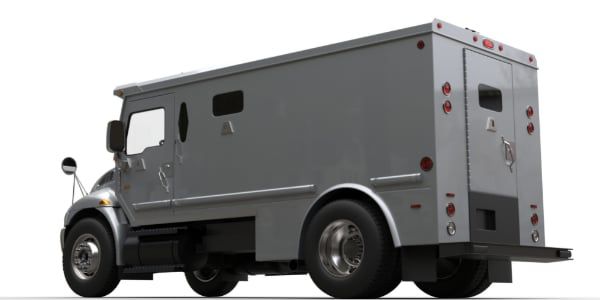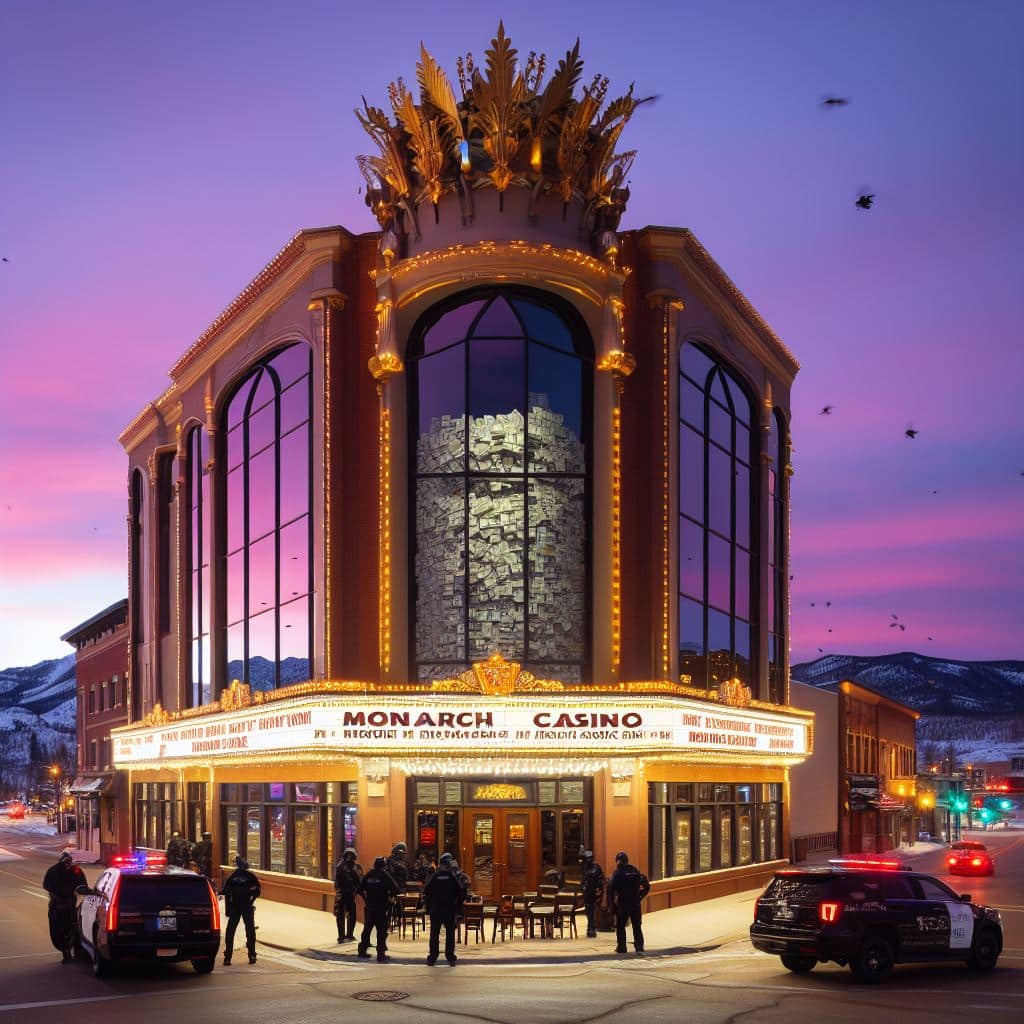Introduction
In the thrilling realm of true crime, few narratives captivate us quite like the audacious tales of casino heists and casino robberies. These stories, where fortune favors the bold and the stakes are sky-high, have a unique allure that keeps us on the edge of our seats. From Las Vegas to London, casinos have often been the target of some of the most daring heists in history. Our fascination with these real-life dramas is deeply rooted in our collective psyche.

In this blog post, we discuss the intriguing world of casino heists, exploring fifteen of the biggest and most audacious casino robberies in history. From the 'Biker Bandit' at the Bellagio to the $33 million heist at the Crown Casino, we'll uncover the daring exploits of those who dared to take on some of the world's most secure establishments. So, buckle up and prepare for a thrilling journey into the world of high-stakes crime.
Why are Casinos Prime Targets for Heists?
Casinos, with their glitz and glamour, have always been a magnet for thrill-seekers and fortune hunters. But beyond the allure of the gaming tables and slot machines, these establishments have also attracted a more nefarious element: criminals looking to make a quick fortune. In this section, we explain why casinos are prime targets for heists and highlight some of the biggest casino robberies in history.
Casinos are attractive targets for thieves and other criminals. The large amounts of cash on hand, coupled with the constant flow of people, provide ample opportunities for illicit activities. From embezzlement and fraud to money laundering and tax evasion, casinos can sometimes serve as fronts for a variety of illegal activities.

While most heists were carried out by individuals or small groups, there have also been instances of organized teams carrying out elaborate schemes to defraud casinos. The MIT blackjack team, for instance, used card counting techniques to win an estimated $22 million to $57 million from Las Vegas casinos between 1979 and 1994.
Such examples illustrate the audacity and complexity of casino heists. Whether it's a lone individual brandishing a gun or a team of mathematicians counting cards, these crimes underscore why casinos remain prime targets for heists and robberies. Despite the high risks involved, the potential rewards continue to lure criminals, making casino security an ongoing challenge.
What is the Difference Between a Heist and a Robbery?
In the world of crime, terms like "heist," "robbery," and "burglary" are often used interchangeably. However, they each have distinct meanings that set them apart. Understanding these differences is crucial when discussing the 15 biggest casino heists and robberies in history.

A robbery, as defined by common law, is the act of taking or attempting to take anything of value by force, threat of force, or by instilling fear. It involves the unlawful taking away of personal property from a person through violence or the threat of violence. Robberies are typically crimes of opportunity and can occur anywhere, not just at home. The key element here is the use of force or intimidation against another person.
On the other hand, a heist is a specific type of theft that involves the illegal acquisition of cash or valuable objects such as artworks, jewelry, or bullion. This can take the form of either a burglary or a robbery. The term "heist" often conjures images of grand, meticulously planned operations targeting high-value targets, such as banks or casinos.
The difference between a heist and a robbery lies in the nature of the crime. A heist is usually more strategic and involves detailed planning, while a robbery is often more spontaneous and violent. In English and Welsh law, the distinction is that a robbery uses force, meaning some heists commonly known as robberies were actually burglaries.
Burglary, meanwhile, is characterized by the intent to commit a theft or felony by breaking into a place. It doesn't necessarily involve the use of force against a person, unlike robbery. Some crimes, such as home invasions, can have attributes of both burglary and robbery.
In summary, while all three terms - heist, robbery, and burglary - involve illegal activities and theft, they differ in their execution. A robbery involves force or threat against a person, a burglary involves breaking into a place with the intent to steal, and a heist is a well-planned theft of high-value items, which can be executed as either a robbery or a burglary. As we delve into the tales of the biggest casino heists and robberies, these distinctions will become even more apparent.
Techniques Used in Robberies
Casino robberies are complex crimes that often require precise planning and execution. The methods used by criminals to commit heists vary from one robbery to another, though there are some common techniques utilized by the perpetrators Here are some of the techniques used by criminals to pull off these daring robberies:
- Insider access: Employees like Bill Brennan and Rolando Ramos used their intimate knowledge of operations and procedures to steal directly from the casino.

- Deception: Disguises, fake credentials, and distractions allowed thieves like Anthony Carleo to deceive security and make off with the loot.
- Neutralizing security: Aggressive robbers like Jose Vigoa's gang overpowered guards and disabled security measures before raiding the vaults.
- Smash and grab: Some thieves opted for a more direct approach, brandishing weapons and making brazen grabs of cash or chips from tables and cages.
- High tech hacking: Details are scarce, but cyber-attacks likely played a role in some recent high-value heists like the Crown Casino robbery.
- Inside jobs: Collusion with casino staff helped criminals gain access, disable alarms, and avoid detection.
- Meticulous planning: Scoping the site, gathering intel, coordinating timing, and establishing escape routes were key to successful complex heists.
- Sheer audacity: In some cases, the boldness and daring of the robbers allowed them to catch casinos off guard and make their getaway.
While the lure of outwitting casino security is great, these criminal acts often lead to long prison sentences. Better to walk away from the tables ahead than attempt to steal the house's fortune.
What Percentage of Casino Heists and Robberies is successful?
The list of the biggest real-life casino heists of all time includes the Crown Casino Heist, where a staggering $33M was stolen and the MIT Blackjack Team that made off with between $22M to $57M. However, it's important to note that while these figures are impressive, they do not necessarily represent success. Many of these heists ended with the perpetrators being caught and facing severe legal consequences.

The reality is that the majority of casino heists end in arrest and prosecution. The percentage of successful casino heists and cases in which people successfully robbed casinos is relatively low, making them a high-risk endeavor with potentially devastating consequences.
How Many Heists Happen in Las Vegas?
Las Vegas, often referred to as Sin City, is renowned for its vibrant nightlife, luxurious casinos, and high-stakes gambling. However, this glittering city has also been a hotbed for some of the most audacious casino heists in history. While it's difficult to pinpoint an exact number of heists that have occurred in Las Vegas due to the clandestine nature of these crimes and the fact that not all are reported or solved, it's safe to say that the city has witnessed a significant number of robberies over the years.

From the 1930s to the present day, Las Vegas casinos have been targeted by both amateur and professional criminals, each attempting to make their fortune at the expense of these establishments. The allure of quick riches has led to a variety of heists, ranging from inside jobs orchestrated by casino employees to daring robberies carried out by seasoned criminals.
The frequency of these heists has ebbed and flowed over the decades, with some periods seeing a higher incidence than others. However, it's important to note that any robbery on the Las Vegas Strip is likely to make headlines, underscoring the fact that these incidents, while not commonplace, are not as rare as one might think.
In conclusion, while it's challenging to provide a precise answer to the question of how many heists have happened in Las Vegas, the city's history is undeniably marked by a series of notorious casino robberies. These audacious acts serve as a stark reminder of the darker side of Las Vegas' glitz and glamour.
Fact Check: What was the Largest Casino Robbery in History?
- The largest casino robbery in Las Vegas history took place at the Circus Circus Casino in October 1993, where around $3.1 million was stolen.
- The largest casino heist in history worldwide occurred at the Crown Casino in Melbourne, Australia in 2006, where $32 million in casino chips were stolen.
Top 14 Casino Heists
Out team went through all facts and created the following list for our readers. From the simplicity of Bill Brennan's Stardust Robbery to the staggering $33 million Crown Casino Melbourne heist, these daring escapades have etched their names in history. Stay tuned as we unravel the tales of the 15 most notorious casino robberies ever committed.
1. The Bellagio Casino Heist (December 14th, 2010)
In the annals of casino heists, few are as audacious and infamous as the Bellagio Casino Heist of December 14th, 2010. The man behind this daring act was none other than Anthony Michael Carleo, also known as the 'Biker Bandit.' Carleo, the son of a Las Vegas judge, had a plan that was as simple as it was bold.

On that fateful day, Carleo walked into the world-renowned Bellagio Casino wearing a motorcycle helmet to conceal his identity. Brandishing a gun, he approached a craps table and made off with $1.5 million worth of chips. The entire operation took less than three minutes, leaving patrons and staff stunned. Remarkably, no shots were fired, and no one was hurt during the heist.
Carleo's audacity didn't end there. Despite the high risk, he returned to the Bellagio the very same night, blending in with the gamblers and even cashing in some of the stolen chips. Over the following weeks, he lived a life of luxury at the casino's expense, spending lavishly on drugs, women, and gambling. However, his reckless behavior and the difficulty of cashing in the high-value chips without raising suspicion eventually led to his downfall.
The consequences of Carleo's actions were severe. On August 23, 2011, District Judge Michelle Leavitt sentenced him to between three and eleven years in prison for armed robbery and assault with a deadly weapon. His audacious heist, while initially successful, ultimately led to his incarceration, serving as a stark reminder of the risks and repercussions associated with such criminal acts.
The Bellagio Casino Heist remains one of the most notorious in history, not just for the amount stolen but also for the audacity of the robber and the dramatic fallout. It stands as a testament to the fact that while the allure of a big score can be tempting, the house always wins in the end.
2. The MIT Blackjack Heist (1979-1993)
Few stories in the history of casinos are as enthralling as the tale of the MIT Blackjack Team. This group of students and ex-students from the Massachusetts Institute of Technology, Harvard University, and other prestigious institutions, used their mathematical prowess to outsmart casinos worldwide. Their weapon of choice was not guns or threats, but card counting - a blackjack strategy that involves keeping track of high and low valued cards dealt to determine who has the advantage on the next hand.

The team's journey began in 1979 when six MIT students taught themselves card-counting and traveled to Atlantic City during spring break to win their fortune. Over the years, the team grew to nearly 80 players, with groups operating in various locations including Las Vegas, Atlantic City, Canada, and even island locations. They became so successful that they had to resort to increasingly elaborate measures to avoid detection.
One of the most notable members of the team was Bill Kaplan, a Harvard MBA graduate who had previously run a successful blackjack team in Las Vegas. Kaplan joined the team in 1980 and under his guidance, the team's methods were enhanced and their success skyrocketed. In 1992, seeing the booming gambling industry, Kaplan and his partners formed a new company, Strategic Investments, which trained bright students to card count and gamble, then unleashed them on unsuspecting casinos.
Their biggest win came in the summer of 1992 when they won an incredible $1.5 million at the Las Vegas Desert Inn Casino. However, the exact amount the team won over the years is unknown, with reports ranging from $22 million to $57 million.
Despite their success, the team faced increasing pressure from casinos. Investigators hired by casinos eventually connected the dots and realized that many of those they had banned had addresses in or near Cambridge, leading them to the MIT team. By December 1993, the increasing heat led to the dissolution of Strategic Investments, marking the end of Kaplan's blackjack career.
The story of the MIT Blackjack Team is a testament to the power of intellect and strategy. While they may not have physically broken into a vault or held anyone at gunpoint, their heist was no less impressive. They managed to beat the house at its own game, proving that sometimes, the pen (or in this case, the brain) truly is mightier than the sword. In 2008, the movie 21, based on the book "Bringing Down the House" by Ben Mezrich, was released, further popularizing the story of the MIT Blackjack Team and their incredible heist. It ranks among the best gambling movies ever.
3. The Monte Carlo Casino Heist (March 25th, 2017)
The Monte Carlo Casino Heist of March 25th, 2017 is particularly notable for its boldness and theatrical execution.

On that memorable day in March 2017, the tranquility of this glamorous establishment was shattered when it became the target of a adventurous robbery. The fearless plot was executed by a group of three gangsters who attempted to distract emergency services and police by starting a fire in a nearby tunnel. As the emergency services rushed to put out the fire, the gangsters seized the opportunity to raid the Cartier shop situated on the square where the casino is located.
The robbers were not content with just stealing; they also resorted to violence. One person was wounded by gunfire during the heist. Two of the robbers were arrested, but the third managed to escape and was last seen in an underground car park opposite the casino. In the aftermath of the robbery, Monte Carlo went into lockdown, with the casino shut and shops pulling down their security screens.
The value of the jewelry taken during the heist was not immediately estimated, but the audacity of the crime sent shockwaves through Monaco and beyond. The heist highlighted the vulnerability of even the most secure establishments and led to a significant increase in security measures at the casino.
The Monte Carlo Casino Heist of 2017 remains one of the most merciless in history, demonstrating the lengths to which criminals will go to exploit opportunities and the importance of robust security measures in protecting valuable assets.
4. The Riviera Heist (1992)
The Riviera Heist of 1992 is a remarkable event in the chronicles of crime, showcasing an audacious theft and a clever criminal strategy. This incredible heist took place in the sun-drenched city of Riviera Beach, Florida, where a seemingly ordinary man vanished without a trace after leaving his job at a local security company. The details surrounding his disappearance remain shrouded in mystery, adding an intriguing layer to this already captivating tale.

The Riviera Heist was not just about the theft of physical assets; it was also a psychological game of cat and mouse. The thief, who had been living a quiet life as a couch-potato fugitive, managed to elude capture for an extended period, leaving law enforcement agencies baffled and frustrated. Despite a $25,000 reward offered for information leading to the arrest of those responsible, the perpetrators remained at large, further cementing the Riviera Heist's place in the annals of infamous robberies.
While the exact value of the stolen goods remains undisclosed, the audacity of the crime and the subsequent evasion of justice have ensured that the Riviera Heist is remembered as one of the most significant robberies in history. The case serves as a stark reminder of the lengths to which criminals will go to secure their ill-gotten gains and the challenges faced by law enforcement agencies in bringing such individuals to justice.
As we delve deeper into the world of casino heists and robberies, the Riviera Heist stands as a testament to the cleverness of thieves and the enduring allure of the high-stakes world of gambling establishments. It's a story that continues to captivate audiences, serving as a stark reminder of the darker side of the glitz and glamour associated with casinos.
5. The Circus Casino Heist (October 1st, 1993)
Few casino heists have ever matched the audacity and intrigue of the Circus Casino Heist of 1993. On October 1st, Heather Tallchief, a 21-year-old former nursing assistant, and her partner Roberto Solis, orchestrated one of the most daring thefts in Las Vegas history, making off with an estimated $3 million.
Tallchief was employed by Loomis Armored, a company contracted to service local Las Vegas casinos, including the Circus Hotel & Casino. Her job involved filling ATM machines at the casinos with cash, a routine task that took a dramatic turn when she disappeared with the armored van and its hefty payload. Initially, it was suspected that Tallchief was a victim of a heist, but it soon became clear that she had absconded with the money.

The plot thickened when, after 12 years on the run, Tallchief turned herself in, claiming that she had been brainwashed into committing the heist by Solis. She served her prison sentence and has since been released, while Solis remains a fugitive, considered armed and dangerous to this day. The stolen money has never been recovered.
This robbery is featured in the Netflix documentary "Heist" and continues to captivate audiences with its blend of intrigue, suspense, and mystery. Despite the passage of time, the Circus Casino Heist remains one of the most daring and infamous casino robberies in history.
6. The El Dorado Casino Heist (February 23rd, 2017)
The El Dorado Casino Heist, which took place on April 6, 2004, is renowned in the history of casino robberies for its remarkable level of boldness and criminality. The El Dorado Resort Casino, a prominent hotel and casino located in Downtown Reno, Nevada, became the stage for this notorious crime. The Carano family, who had been involved in the gaming industry since patriarch Don Carano converted some family-owned vacant land into the Eldorado Hotel-Casino in 1973, were the unfortunate victims of this brutal act.

The heist was meticulously planned and executed with precision, reminiscent of the Diamond Casino Heist challenges where participants are required to complete the heist in under 15 minutes without getting detected or wasting any lives. However, unlike these fictional challenges, the consequences of the El Dorado Casino Heist were all too real.
The tranquility of the casino was shattered when an officer-involved shooting took place inside the resort. The incident resulted in one fatality, marking a dark day in the history of the Eldorado Casino Resort. The police responded swiftly to the deadly shooting, but the culprits had already made their escape, leaving behind a trail of chaos and fear.
This robbery underscores the fact that casinos, with their vast amounts of cash and valuable assets, are often prime targets for criminals. Despite the tragic outcome of the El Dorado Casino Heist, it has become a part of the lore of casino heists, joining the ranks of other infamous robberies.
7. The Star City Casino Heist (March 6th, 2005)
The mastermind behind this daring robbery was none other than a croupier named Dudille Nkabinde, who had been working at the Stanley Casino at Star City for 18 months.
The heist took place on March 6, when Nkabinde, armed with a firearm, forced his fellow workers into a vault during a count of the previous night's takings. He then proceeded to gather a total of £75,890 before making his escape. His victims were released from their ordeal about half an hour later.

Nkabinde's actions were not without premeditation. About a month prior to the robbery, he had asked another croupier if he could procure a gun for him. This request was refused, but it did not deter Nkabinde from carrying out his plan.
Following the heist, Nkabinde travelled north and then to London. His journey came to an abrupt end at Euston Station, where he was arrested by armed officers after a train from Manchester was held up under the guise of signalling difficulties. This delay allowed the officers enough time to assemble and apprehend Nkabinde.
In a twist of events, Nkabinde claimed that most of the stolen money had been taken from him by prostitutes in London. However, this claim was dismissed by Judge Alistair McCreath, who sentenced Nkabinde to nine years in prison and recommended his deportation. The judge noted that the crime involved a significant amount of money and was of 'considerable gravity'.
Nkabinde's defence argued that he needed the money to pay off a loan shark in South Africa. Despite this, nearly £53,000 of the stolen cash remained unaccounted for.
8. The New Frontier Casino Heist (October 15, 1982)
The New Frontier Casino, located in the heart of Las Vegas, Nevada, has a rich and tumultuous history. Originally opened in 1942 as the Hotel Last Frontier, it was the second resort to be built on the famous Las Vegas Strip. However, it wasn't just the glamour that made this casino famous. On October 15, 1982, it became the site of one of the most infamous heists in history.
The casino had been under surveillance for months by a group of skilled criminals who meticulously planned their operation. The heist was executed with precision, leaving the casino staff and security completely blindsided. It was a daring jewelry theft rather than a traditional casino heist. Six men disguised as businessmen and wearing pig masks entered the New Frontier Casino in Las Vegas. They targeted the casino’s jewelry store on the second floor, where they swiftly broke the display cases and made off with nearly $4 million in jewelry.

Despite extensive efforts by the police, including following false leads and dead ends, the perpetrators were never caught. The robbers appeared to have inside knowledge of the casino’s layout and security protocols, leading to speculation of a connection to organized crime. However, this theory was never substantiated, and the robbery remains unsolved. The New Frontier Casino Heist stands out as one of the most notorious unsolved casino robberies in history, leaving it as an example of an almost perfect crime.
Despite the negative impact of the heist, the New Frontier Casino managed to bounce back. It continued to operate until 2007 when it was finally demolished. Today, the site where the casino once stood remains vacant. It serves as a cautionary tale for other casinos, reminding them of the importance of robust security measures and vigilance.
9. The Casino Arizona Heist (2018)
In the summer of 2018, a significant casino heist took place in Payson, Arizona. The Mazatzal Casino, located on the Tonto Apache Indian Reservation, was targeted by two individuals who were later identified as Ryan Pearson and Armando Ochoa. Both Pearson and Ochoa were employees of the casino, which made the crime even more shocking.
On July 17, 2018, dressed in black attire complete with hoods and masks, they stormed into the casino shortly after midnight. Brandishing firearms and firing multiple rounds, they managed to intimidate their own co-workers into handing over cash. The robbers made off with a staggering $650,000. Miraculously, no one was hurt during the robbery.

The culprits were not professional criminals but employees of the casino itself. Ryan Pearson, 31, and Armando Ochoa, 32, were arrested by the Federal Bureau of Investigation. Of the stolen money, federal court records indicate that some $480,000 has been recovered, with no word on the status of the remaining amount.
The legal proceedings that followed saw both men pleading guilty to their crimes. Pearson, who had admitted to using a firearm during the robbery, was sentenced on April 15, 2019, by Judge Susan M. Brnovich in U.S. District Court in Phoenix. He received a five-year prison sentence, followed by three years of supervised release. Ochoa, who had also confessed to using a weapon during the heist, was sentenced earlier in March. He was handed a ten-year prison sentence, followed by three years of supervised release.
10. The Soboba Casino Heist (August 2, 2007)
This robbery took place on August 2, 2007, at the Soboba Casino in Riverside County, California. The masterminds behind this heist were two casino employees, Rolando Luda Ramos, a 27-year-old surveillance technician, and Eric Alan Aguilera, a 25-year-old fellow employee.
The plot was meticulously planned and executed with precision. Ramos, under the guise of repairing surveillance equipment, managed to gain access to the casino vault. He had previously disabled the surveillance cameras and held employees at gunpoint, effectively putting them out of operation and preventing them from alerting authorities. Meanwhile, Aguilera, who was well-versed with the casino's layout and security systems, played a crucial role in the planning and execution of the heist.

The duo managed to steal an astounding $1.5 million during the robbery. They divided the loot and went their separate ways, hoping to evade capture. However, their freedom was short-lived. Both men were arrested within days of the heist, and nearly all the stolen money was recovered and returned to the casino.
Ramos later claimed in a jailhouse interview that he was high on cocaine during the heist and acted on adrenaline. He also tried to downplay his role in the crime, stating that Aguilera was the real brains behind the operation. Despite these claims, both men were convicted for their roles in the heist. Ramos was found guilty of nine counts of robbery, among other charges, while Aguilera was convicted of seven counts of robbery.
11. The Crown Casino Heist (2013)
In March 2013, Crown Casino in Melbourne, Australia was the victim of a sophisticated heist that saw a high roller make off with over $33 million AUD. The Crown Casino heist ranks among the most notorious casino heists ever.
The heist was carried out by a foreign VIP player in the high-stakes rooms with the help of someone on the inside - an employee who helped hack into the casino's own surveillance system. The hacker was able to manipulate the security cameras to conceal his activities at the baccarat table where he won over $33 million in the space of just eight hands.

With control over the cameras, the perpetrators were able to avoid detection, carrying out the heist swiftly and discreetly. The scam was only discovered later when casino officials reviewed the surveillance footage and realized it had been tampered with.
An investigation was launched, security tightened, and the staff member involved was dismissed. Most of the stolen money was ultimately recovered, but it still goes down as one of the biggest casino heists in history thanks to the huge haul. The cunning exploitation of the casino's own security system also makes it a particularly bold and clever robbery.
For any casino, an inside job poses a major security threat and the Crown Casino heist highlights why casinos need stringent measures to vet staff and monitor access to surveillance systems. It was an clever theft requiring meticulous planning, coordination, and nerves of steel to pull off.
12. The Mandalay Bay Heist, Las Vegas (March 11th, 2005)
One of the most brazen casino heists in Las Vegas history occurred in 2005 at the Mandalay Bay Resort and Casino. On March 11, 2005, two masked gunmen entered the casino and approached a change booth. Brandishing their weapons, they fired warning shots up at the ceiling and forced the workers in the change booth to get on the ground. The robbers proceeded to steal an undisclosed amount of cash from the booth before fleeing to a getaway vehicle they had parked near an entrance.

The Mandalay Bay casino is located at the far southern end of the Las Vegas Strip. When it opened in 1999 after nearly $1 billion in construction costs, it was the largest and most expensive resort ever built in Las Vegas. The 43-story hotel tower is an iconic part of the Strip skyline, and Mandalay Bay is known for its entertainment and conventions facilities as well as its 135,000 square foot casino.
Despite the casino's tight security, the two thieves were able to pull off the daylight robbery and escape unharmed and without being immediately apprehended. The brazen nature of the crime - firing shots inside a crowded casino in broad daylight - shocked Las Vegas, a city used to casino robberies. Though casino heists were more common in Las Vegas's early mob-run days, they were rare by 2005. Neither Mandalay Bay nor the Las Vegas Police disclosed how much money was stolen in this robbery, adding to its mystery and legend.
The Mandalay Bay Heist was not an isolated incident. In fact, it was part of a worrying trend of casino robberies that plagued Las Vegas in 2005. Just a week before the Mandalay Bay incident, the Bourbon Street Casino had also fallen victim to an armed robbery, marking the ninth such crime that year and the second since 2003.
13. The Ritz Casino London Heist (2004)
In March 2004, a daring heist took place at the prestigious Ritz Casino in London, located beneath the famous Ritz Hotel on Piccadilly. On two separate nights that month, a trio consisting of a 32-year-old Hungarian woman and two Serbian men aged 33 and 38 targeted the casino's roulette tables in an elaborate scheme to cheat the house.
The group was suspected of using a laser scanner hidden inside a mobile phone to measure the velocity of the roulette ball after it was spun. This data was transmitted to a computer, which rapidly calculated the section of the wheel the ball was most likely to land in. The prediction was sent back to the mobile phone just before betting closed, allowing the trio to place high-stakes bets with improbable accuracy.

On their first night at the tables, the gang walked away with £100,000 in winnings. When they returned the next evening, their system enabled them to win an astonishing £1.2 million more. The Ritz paid out £300,000 in cash and issued a cheque for the outstanding balance. Suspicious of foul play, the casino contacted Scotland Yard after reviewing security footage. Police arrested the trio at their hotel, seizing their phones and a large amount of cash.
Though detained on suspicion of cheating, the three gamblers were eventually released without charge. After nearly 9 months of investigation, authorities found insufficient evidence that a crime had occurred. All funds confiscated by police were returned, allowing the suspects to keep their £1.3 million winnings. The bold heist revealed vulnerabilities in casino security and elevated the risks of high-tech cheating methods.
14. The Treasure Island Casino Heist (2000)
The incident took place in the year 2000 and was orchestrated by a man named Reginald Johnson. Johnson, who was 27 years old at the time, targeted the casino three times over a six-month period.
His first two attempts were successful, with him managing to steal $55,000 in July and approximately $30,000 in October. However, his luck ran out during his third attempt in December. The casino had installed bars around the cashier's desk following the previous robberies, which foiled Johnson's plan.
During this failed attempt, Johnson ended up shooting at and injuring security guards. Despite the increased violence, Johnson managed to escape the scene. However, the police were hot on his trail. Using the evidence and leads they had gathered from the previous robberies, they were able to track him down
This led to his arrest and subsequent guilty plea to charges of robbery and attempted murder.
2023 Heists
The 2023 Monarch Casino Heist (Black Hawk, Colorado)
The 2023 Monarch Casino Heist in Black Hawk, Colorado has been in the media over months and stands out for the sheer amount of money stolen. This daring theft is considered the largest casino heist in the state's history since legal gaming began in 1991.

The heist took place in the early hours of March 12, 2023, just as Daylight Saving Time began. The main perpetrator was a casino cashier named Sabrina Eddy, who was caught on surveillance video removing cash bricks, each worth $50,000, from the vault in the casino cage. She then packed the money into boxes, concealed it with rags, sealed the boxes, and left the casino parking garage in her minivan. The total amount stolen was a staggering half a million dollars.
Eddy initially claimed innocence, insisting that she had been ordered to remove the cash by someone she believed to be a casino boss. She said she had made two separate trips to deliver the money to an "attorney" in the parking lot of St. Anthony's Hospital in Lakewood, under the threat that the casino would be "in breach of contract" if she didn't comply.
However, inconsistencies in her story led investigators to administer a polygraph test, which indicated deception. Under further questioning, Eddy broke down and admitted that she had been coerced into participating in the theft by unknown associates of her deceased former husband, who had threatened her family members via email and phone calls.
A second suspect, Juan Gutierrez-Zambrano, 31, was arrested later and charged with theft of $100,000 to $1 million. Investigators used traffic cameras, vehicle registration, cell phone records, and an oil change receipt to link him to the crime. Despite these arrests, the stolen money was never recovered.
The 2023 Caesars Palace Casino Heist
The man behind this infamous crime was none other than James Booth, a 37-year-old with a history of criminal activity.
On January 9, 2023, Booth walked into the bustling Caesars Palace casino on the Las Vegas Strip with a single, chilling demand: "Give me hundreds or I'll shoot you." Threatening a manager working in the main casino cage, Booth reached into his pocket, implying the presence of a deadly weapon. Fearing for his life, the manager complied, handing over two bands of $20 bills amounting to $4,000.

Booth then calmly walked to the valet area of the Strip casino, but his escape was short-lived. Casino security and Las Vegas police quickly apprehended him outside the casino. Despite the gravity of his crime, Booth reportedly had a large smile on his face when he arrived at the Clark County Detention Center, claiming he did not remember the robbery.
This wasn't Booth's first brush with the law. In August of the previous year, he had pleaded guilty to battery on a protected person and served 16 days in jail. Following the Caesars Palace incident, he was booked into the detention center again, facing a charge of robbery with a deadly weapon. His bail was set at $25,000, and he was scheduled to appear in court again on January 25.
The Caesars Palace Robbery is a stark reminder of the lengths some individuals will go to in their pursuit of easy money. It also underscores the importance of robust security measures in casinos, which often become targets due to the large amounts of cash they handle daily.
Advanced Questions
How Do Casinos Prevent Theft and Protect their Assets?
Casinos have always been a tempting target for thieves and fraudsters, given the large sums of money that change hands daily. However, over the years, casinos have significantly ramped up their security measures to protect their assets and prevent theft and fraud.
Today, casino security is a sophisticated operation that combines physical security forces with specialized surveillance departments. These teams operate an extensive network of cameras throughout the property, enabling them to monitor every corner of the casino floor in real-time. The footage from these cameras is also stored, allowing security officials to retrospectively track a criminal's behavior within the casino if a crime is committed.
One of the most effective security measures employed by casinos is chip tracking technology. This system allows for real-time monitoring of chip movement, helping to quickly identify and flag any fraudulent or unauthorized chips. It also minimizes the risk of theft or unauthorized circulation of chips.

In addition to this, casinos have strict internal controls to prevent financial crimes. These include mandatory background checks for employees and regular audits of financial records. Casinos also work closely with law enforcement agencies to monitor suspicious activity and comply with Anti-Money Laundering (AML) regulations.
Furthermore, modern casinos use facial recognition software to identify known cheaters or criminals in real-time, even if they are wearing a disguise. This technology has improved significantly over the past two decades and is now a crucial tool in the casino security arsenal.
Access to sensitive areas within the casino, such as count rooms and surveillance rooms, is strictly controlled. Authorized personnel wishing to enter these areas must go through a series of "man traps" - doors that lock or unlock in sequence, similar to those found in commercial banks.
Finally, casinos are increasingly leveraging advanced technologies like AI and deep learning to enhance their security measures. These technologies can help detect suspicious behavior that might otherwise go unnoticed in large crowds, ensuring that casinos remain a step ahead of would-be thieves and fraudsters.
In conclusion, while the allure of a big score may continue to tempt some, the reality is that modern casino security measures make successful heists increasingly unlikely.
What does a Casino Vault look like?
Casino vaults are the heart of any gambling establishment, safeguarding millions upon millions of dollars. These vaults are not just simple safes; they are fortresses of security, equipped with some of the world's most advanced security systems. The cash reserves within a casino are stored in a series of these safes, each one more secure than the last.

The physical structure of these vaults is designed to be impenetrable. They are guarded by heavy doors with complex mechanisms that allow only authorized individuals to gain access. The walls and floors of these vaults are made of thick steel, making any attempt to drill through them a task that would take days, if not weeks.
Inside the vault, the money is present in two forms: chips and cash. The chips are tracked across the casino floor, ensuring that any chips involved in an attempted robbery will be flagged if used at the casino or another casino in the future.
The security measures extend beyond the physical structure. Casinos employ a physical security force, often trained professionals who patrol the casino floor and respond to calls for assistance and reports of criminal or suspicious activities. Additionally, a specialized surveillance department operates the casino's closed-circuit television system, keeping a watchful eye on every corner of the establishment.
On the floor, facial recognition technology makes a significant difference. It allows real-time footage of those involved to be compared to database information, enabling the identification of individuals and appropriate responses.
In the event of a robbery, silent alarms are used to alert local law enforcement without the robber's knowledge. These alarms are also installed in the vaults, giving the authorities ample time to respond while the thieves remain oblivious.
Furthermore, casinos use advanced technology like NORA (Non-Obvious Relationship Analysis) to conduct background checks on anyone who appears suspicious. This system can identify relationships between known cheaters and possible accomplices, as well as determine if any guest has a criminal record.
In conclusion, the security measures in place for casino vaults are extensive and sophisticated, making them some of the most secure locations in the world. While Hollywood movies like Ocean’s Eleven may make it seem easy to break into these vaults, the reality is far from it. The combination of physical security, advanced technology, and strict protocols makes casino vaults nearly impregnable, ensuring the safety of the vast sums of money within.
How Do Casinos Recover From These Losses? Are There Insurances?
The answer lies in a specialized form of protection known as casino insurance. This type of commercial property and liability insurance provides coverage against a wide range of potential threats, including theft, fire, natural disasters, and other events that could result in substantial financial loss.

Casino robberies can result in significant financial losses. These incidents highlight the potential risks that casinos face and underscore the importance of having mechanisms in place to recover from such events.
One of the primary ways casinos manage these risks is through insurance. Casino insurance is a type of commercial property and liability insurance specifically designed to cover the unique risks faced by casino owners and operators. This coverage includes protection against a range of potential threats, including fire, natural disasters, and theft.
High-limit Casino Umbrella insurance, for example, can provide coverage up to $170 million, offering substantial financial protection in the event of a catastrophic incident. In addition to standard coverage, many insurance providers offer specialized products tailored to the needs of the gaming industry. American Special Risk, for instance, has developed unique coverages for companies operating in the gaming industry, focusing on Fidelity and Crime insurance. These policies are designed to address the risks associated with handling large volumes of money, providing protection against losses from both internal and external parties.
Despite these precautions, some robberies do occur. When they do, casinos rely on their insurance coverage to recoup their losses while law enforcement agencies work to apprehend the culprits. While the process can be challenging, the combination of robust security measures, comprehensive insurance coverage, and effective law enforcement partnerships enables casinos to recover and continue their operations.
Are There Many Unsolved Million-Dollar Casino Heists?
Throughout history, casinos have been the target of daring heists resulting in millions of dollars in losses. While many of these crimes are eventually solved, some remain complete mysteries to this day. In other cases, the criminals were never arrested.

- The Bill Brennan Heist at the Stardust Hotel and Casino in Las Vegas in 1992, where Brennan stole $507,361 in cash and chips. He was never found and remains on the FBI's Most Wanted list.
- The Horizon Casino Heist in Vicksburg, Mississippi in 2003, where a masked robber stole $60,000 after claiming he had planted bombs in the building. The perpetrator was never identified or captured.
- The theft of $500,000 from the sportsbook at the Stardust Casino in Las Vegas by cashier Bill Brennan in 1992. Brennan disappeared and was never arrested.
- The Bellagio Casino robbery in 2010 where Anthony Carleo, the "Biker Bandit," stole $1.5 million in chips from a craps table while wearing a motorcycle helmet. He has never been found.
- The robbery of $150,000 from the Stardust Casino by security guard Royal Hopper and his sons in the late 1970s. None of them were ever arrested.
- The theft of $30,000 across three separate robberies of the Treasure Island Casino in Las Vegas in 2000. The robber was never identified.
- The disappearance of $3 million stolen from slot machines by George Jay Vandermark from the Stardust Casino in 1976. Vandermark vanished and was never charged.
Have There Been Any Online Casino Heists?
Online casinos, despite their virtual nature, are not immune to the threat of heists and robberies. However, these incidents are far less dramatic than those that occur in physical casinos, primarily due to the advanced security measures employed by online platforms.
One of the key security elements in online casinos is data encryption. This technology ensures that any sensitive information, such as personal details or financial transactions, is encoded and can only be accessed by authorized individuals. This makes it extremely difficult for cybercriminals to steal or manipulate this data. Another crucial security measure is the use of secure payment methods. The newest trend is using AI to protect their platforms.
To summarize, while online casinos are not immune to security threats, they are equipped with sophisticated security measures that make successful heists and robberies extremely unlikely. As technology continues to advance, so too will the security measures employed by these digital platforms, further safeguarding players' data and finances.
Additional Tips/Resources
Famous Movies and Books about Real and Fictional Casino Heists
Casino heists have long been a source of fascination, inspiring countless movies and books that delve into the thrilling world of high-stakes crime. Here are some of the most famous portrayals of casino heists in popular culture.

In the realm of casino movies in cinema, "Ocean's Eleven" stands out as a classic. The film follows the charismatic Danny Ocean, played by George Clooney, who assembles a team of skilled criminals to rob three Las Vegas casinos owned by the ruthless Terry Benedict. This movie, along with its sequels, has become synonymous with the casino heist genre.
Another notable film is "Bonnie and Clyde," a groundbreaking crime thriller from 1967. Starring Warren Beatty and Faye Dunaway, it tells the story of the infamous criminal couple who robbed banks during the Great Depression. While not strictly about casino heists, it captures the spirit of audacious criminal exploits.
The movie "21" is based on the real-life exploits of the MIT blackjack team, who used card counting techniques to win millions from Las Vegas casinos between 1979 and 1994. The exact amount they won remains unknown, with estimates ranging from $22 million to $57 million.
Turning to literature, "Void Moon" is a gripping thriller set in the surreal world of Las Vegas casinos. The novel follows a young woman who becomes embroiled in a dangerous heist that threatens her life. Another noteworthy book is "Lion on Fire," which tells the story of a recent college graduate who plans a daring heist to save his brother from a deadly debt.
These stories, both real and fictional, capture the allure and danger of casino heists. They serve as a testament to the enduring appeal of these high-risk, high-reward criminal endeavors.
Netflix Docuseries "Heist" - Must Watch!
Premiering on July 14, 2021, the docuseries "Heist" is a captivating blend of original interviews, reenactments, and fast-paced storytelling that will keep viewers on the edge of their seats.

The series, produced by Dirty Robber and directed by Emmy-nominated Derek Doneen, features three of the biggest heists in modern history. One of these is the audacious robbery of a Vegas casino by a 21-year-old woman, Heather Tallchief, and her boyfriend, Roberto Solis. The couple managed to steal a staggering $3.1 million, making it one of the most significant casino heists ever committed.
What sets "Heist" apart from other crime documentaries is its unique perspective. Instead of focusing solely on the crimes themselves, the series delves into the human themes related to them. It explores the emotional journey of the criminals, their tales of redemption, regret, and awakening, making it more than just a recounting of criminal exploits.
Each episode of "Heist" meticulously details every aspect of the heist, from the selection of targets to the intricate planning involved, how they pulled it off, and ultimately, how they ended up getting caught. This comprehensive approach provides an in-depth understanding of the heists, making it a must-watch for true-crime enthusiasts.
So, if you're intrigued by casino heists and want to understand what drives people to commit such daring crimes, "Heist" is a documentary series that should be on your watchlist. It's a fascinating exploration of crime, human nature, and the consequences of actions, all wrapped up in a thrilling narrative that's sure to captivate audiences.
Key Takeaways
The audacious nature of casino heists has long captivated the public's imagination, with their daring plots often serving as inspiration for Hollywood blockbusters. These high-stakes crimes, carried out by fearless individuals or groups, have not only made headlines but have also left an indelible mark on the gaming industry.

From the infamous 'Biker Bandit' heist at the Bellagio in 2010 to the $33 million robbery at Crown Casino Melbourne in 2013, these audacious acts of theft have demonstrated both the allure and the risks associated with attempting to outsmart the security systems of some of the world's most fortified establishments. The motives behind these crimes often range from personal vendettas, as seen in the case of Bill Brennan's Stardust Las Vegas heist in 1992, to the thrill of the challenge, as exemplified by the MIT Blackjack Team's card counting exploits.
However, it is important to remember that while these heists may seem glamorous in retrospect, they are, in fact, serious crimes that have significant repercussions. The impact of these robberies extends beyond the immediate financial loss, affecting the reputation of the casinos involved and leading to increased security measures across the industry.
Law enforcement agencies, utilizing intelligence-led policing and advanced technology, play a crucial role in deterring such crimes and ensuring the safety of both staff and patrons. Yet, despite their best efforts, the mythos surrounding these legendary heists continues to thrive in popular media, serving as a stark reminder of the audacity of those willing to risk it all in the pursuit of unimaginable wealth.
As we reflect on these daring heists, let us not forget the importance of maintaining a safe and secure gaming environment. While the allure of these legendary robberies may persist, the reality is that they represent a breach of trust and security that the gambling industry continually strives to prevent.






